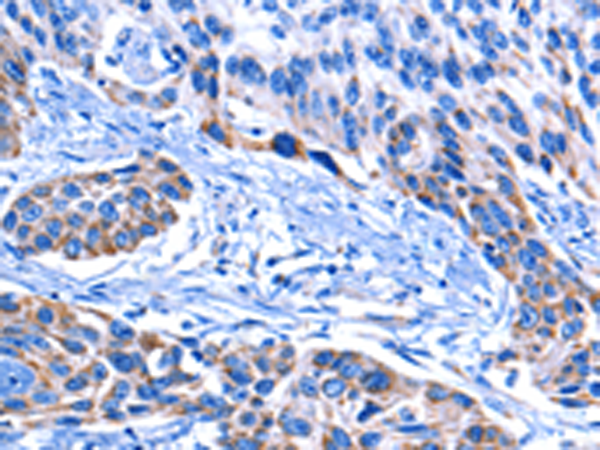

| WB | 咨询技术 | Human,Mouse,Rat |
| IF | 咨询技术 | Human,Mouse,Rat |
| IHC | 1/10-1/50 | Human,Mouse,Rat |
| ICC | 技术咨询 | Human,Mouse,Rat |
| FCM | 咨询技术 | Human,Mouse,Rat |
| Elisa | 1/1000-1/5000 | Human,Mouse,Rat |
| Aliases | CNCA, CNG2, CNCA1, OCNC1, OCNCa, OCNCALPHA |
| WB Predicted band size | 76 kDa |
| Host/Isotype | Rabbit IgG |
| Antibody Type | Primary antibody |
| Storage | Store at 4°C short term. Aliquot and store at -20°C long term. Avoid freeze/thaw cycles. |
| Species Reactivity | Human, Mouse, Rat |
| Immunogen | Fusion protein of human CNGA2 |
| Formulation | Purified antibody in PBS with 0.05% sodium azide and 50% glycerol. |
+ +
以下是关于CNGA2抗体的3篇参考文献的简要整理:
1. **文献名称**:*General anosmia caused by a targeted disruption of the mouse olfactory cyclic nucleotide-gated cation channel*
**作者**:Brunet, L.J. et al. (1994)
**摘要**:该研究利用基因敲除技术构建了CNGA2缺陷小鼠模型,发现其完全丧失嗅觉反应。文中使用CNGA2抗体检测蛋白表达缺失,证实该通道是嗅觉信号传导的核心组分。
2. **文献名称**:*Central role of the CNGA2 channel in odor detection and signal transduction*
**作者**:Munger, S.D. et al. (2005)
**摘要**:通过免疫组化和Western blot分析,验证CNGA2抗体特异性,证明其在嗅觉神经元中的特异性表达,并阐述其在环核苷酸信号级联中的关键作用。
3. **文献名称**:*Characterization of the CNGA2 knockout mouse model for olfactory dysfunction*
**作者**:Michalakis, S. et al. (2003)
**摘要**:研究利用CNGA2抗体进行组织定位和功能验证,发现CNGA2缺失导致嗅觉神经元电生理活性丧失,为研究先天性嗅觉障碍提供了模型基础。
*注:若需更多近期研究,可补充2017年Ibarra-Soria团队在*Nature Neuroscience*发表的单细胞测序研究,文中使用CNGA2抗体作为嗅觉神经元标记物的阳性对照。*
The cyclic nucleotide-gated channel alpha 2 (CNGA2) antibody is a crucial tool for studying the CNGA2 subunit, a key component of cyclic nucleotide-gated (CNG) ion channels. CNGA2. predominantly expressed in olfactory sensory neurons, forms heterotetrameric channels with CNGB1b subunits, enabling the detection of odorants by converting chemical signals into electrical responses. These channels are activated by cyclic nucleotides (e.g., cAMP or cGMP), playing a pivotal role in olfactory signal transduction and sensory perception.
CNGA2 antibodies are widely used to investigate the expression, localization, and function of CNGA2 in physiological and pathological contexts. They facilitate techniques such as Western blotting, immunohistochemistry, and immunofluorescence to assess protein levels in tissues like the olfactory epithelium, brain, and retina. Research using these antibodies has linked CNGA2 dysfunction to olfactory deficits, neurodegenerative disorders (e.g., Alzheimer’s and Parkinson’s diseases), and certain cancers, highlighting its broader regulatory roles beyond sensory systems.
Developed in various host species (e.g., rabbit, mouse), CNGA2 antibodies are validated for specificity via knockout controls. Their applications extend to studying channel assembly, post-translational modifications, and interactions with signaling pathways. As CNGA2 is critical for maintaining cellular excitability and calcium homeostasis, its antibody serves as a vital reagent in neuroscience, molecular biology, and drug discovery, aiding in the exploration of sensory mechanisms and therapeutic targets.
×